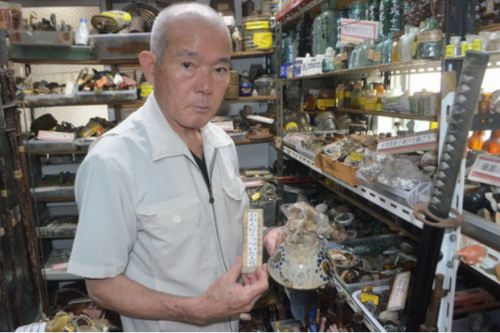Kuniyoshi retires from gathering remains of war dead after 60 years

On April 5 at his house in Sobe, Naha City, Isamu Kuniyoshi shows a bone attached to a bowl.
April 8, 2016 Ryukyu Shimpo
In March, 77-year-old Isamu Kuniyoshi retired from his volunteer role collecting the remains of war dead found in former Japanese military bases in Okinawa. He is stepping down due to his weakening health.
Kuniyoshi had engaged in these activities for about 60 years, collecting more than 3,800 remains and more than 100,000 personal items. His volunteer activities include returning of remains and personal items to bereaved families after identification. Kuniyoshi was one of the central figures leading the work to collect remains in Okinawa. Regarding his retirement, Kuniyoshi said, “I have no regrets.” He hopes to pass down his experience to the next generation.
In the war museum located in Kuniyoshi’s house, bones that were burnt by a flamethrower can be seen attached to a bowl. Bones buried in a melted bin, and sawn off upper-arm bones are also displayed. Artifacts collected by Kuniyoshi such as a recycled syringe, a water bottle with a hole tell the story of the miseries of the Battle of Okinawa.
Kuniyoshi independently obtained research documents on the Imperial Japanese Army bases and bomb shelters collected by the Government of the Ryukyus. He excavated all the bomb shelters and caves he could locate. He recorded the numbers and types of remains and personal items commonly found in bomb shelters and caves.
Kuniyoshi’s childhood experience caused him to devote himself to collecting remains. Kuniyoshi experienced the Battle of Okinawa when he was six years old and lost his grandmother, mother, older brother, younger brother, and niece. When Kuniyoshi was exploring a cave in Jogaku during his childhood, he stumbled upon a mummified body. He could never forget that experience and began collecting remains with his friends when he was in a high school.
One of the most memorable moments of his many years as a volunteer was when he was able to return the remains and personal items to a bereaved family who came from mainland Japan. He said, “The family flew from the mainland of Japan. I will not forget their happy faces.” Some personal items like a pen and a water bottle are only labeled with the last name making it difficult to return the items to bereaved families. He is looking for public institutions that can keep these items.
Photographer Tetsuji Hamada, who has worked together with Kuniyoshi for the past sixteen years and helped to return personal items to bereaved families in mainland Japan said, “Kuniyoshi worked extremely hard for 60 years and devoted his life to collecting remains. I want to pass down his work to the next generation.”
(English translation by T&CT and Megumi Chibana)
Previous Article:Fundraising for ancient Ryukyuan sailing experiment reaches 20 million yen
Next Article:Editorial: Twenty years wasted since Futenma closure agreement
[Similar Articles]
- Information wanted for a discovered pen case with name “Masao Uema”
- A large quantity of ordnance found in Itoman
- 161 college students from outside of Okinawa engaged in collecting remains of war dead
- 10 sets of human remains unearthed in Japanese Army fortified shelter in Urasoe
- Group created to record Isamu Kuniyoshi’s knowledge of remains collection for future generations
 Webcam(Kokusai Street)
Webcam(Kokusai Street)


